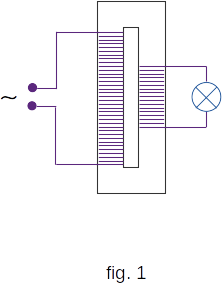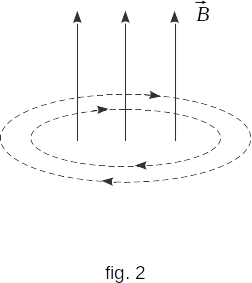From the Electromagnetic induction
135. Vortex electric field
EMF induction occurs either in a fixed conductor placed in a time-varying magnetic field, or in a conductor moving in a magnetic field that may not change with time. The value of EMF in both cases is determined by law \((12-2)\), but the origin of EMF is different. Let us first stop at the first case.
Let's say we have an ordinary transformer in front of us. Once the primary coil is connected to the power supply, we obtain current in the secondary coil (fig. 1) if it is closed. The electrons in the secondary coil wires will move. But what forces make them move? The magnetic field penetrating the coil itself cannot do this, because the magnetic field acts only on moving charges (this is what makes it different from the electric field), and the conductor with electrons in it is fixed.

In addition to the magnetic field, an electric field acts on the charges. And it can also act on static charges. But after all, the field, which we have been talking about so far (electrostatic field), is created by stationary charges, and the induction current appears under the influence of an alternating magnetic field. This suggests that electrons in a fixed conductor are driven by an electric field and this field is directly generated by an alternating magnetic field. This confirms a new fundamental property of the magnetic field - changing in time, the magnetic field generates an electric field. This conclusion was first reached by Maxwell.
Now the phenomenon of electromagnetic induction appears to us in a new light. The main thing in it is the process of birth of an electric field from a magnetic field. There is a conductive circuit (coil) or it is not, it does not change the essence of the case. A conductor with free electrons (or other particles) only helps to detect the appearing electric field. This field moves electrons in the conductor and therefore detects itself. The essence of the phenomenon of electromagnetic induction in this case is not so much in the appearance of an induction current as in the appearance of an electric field.
The electric field appearing from an alternating magnetic field has a very different structure than the electrostatic one. It is not directly related to electrical charges, and its power lines cannot start and end at them. They do not start and end anywhere at all, but represent closed lines like magnetic field induction lines. It is a so-called vortex electric field (fig. 2). In contrast to the electrostatic field, the work of the vortex field on a closed path is not equal to zero. Work on the movement of a single positive charge on a closed path and represents an EMF induction in a stationary conductor.

When the magnetic field of a strong electromagnet changes rapidly, powerful vortex electric field appear, which can be used to accelerate electrons to speeds close to the speed of light. The accelerator of electrons, the betatron, was based on this principle. In this accelerator, the electric current was generated directly in the ring vacuum chamber.